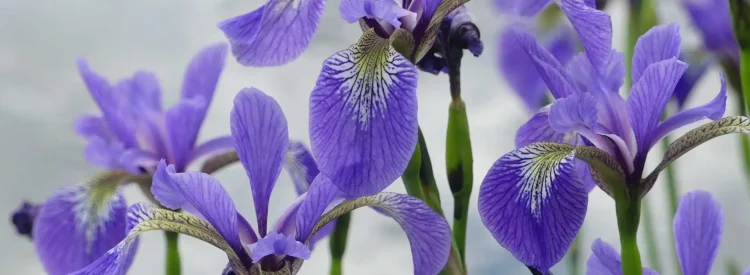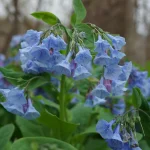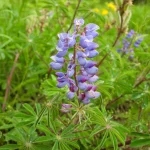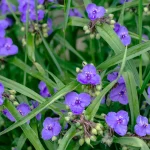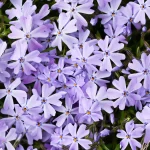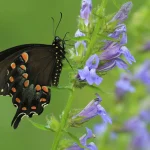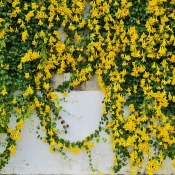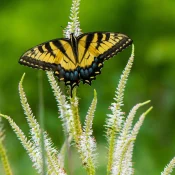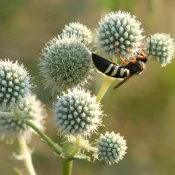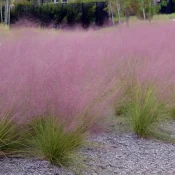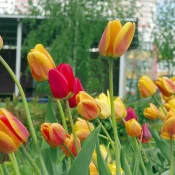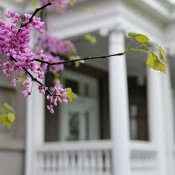This is a plant that everyone needs in their gardens. There are hundreds of irises found worldwide, alongside native iris options for every state in the US (except Hawaii.) These iconic flowers you’ll instantly recognize from Van Gogh paintings. You might think that growing irises is best left to professional gardeners—which is not true! Native irises offer elegant beauty with minimal work. Some also thrive in areas you might not think to plant—like the edge of a pond. Scroll on to meet some favorites.
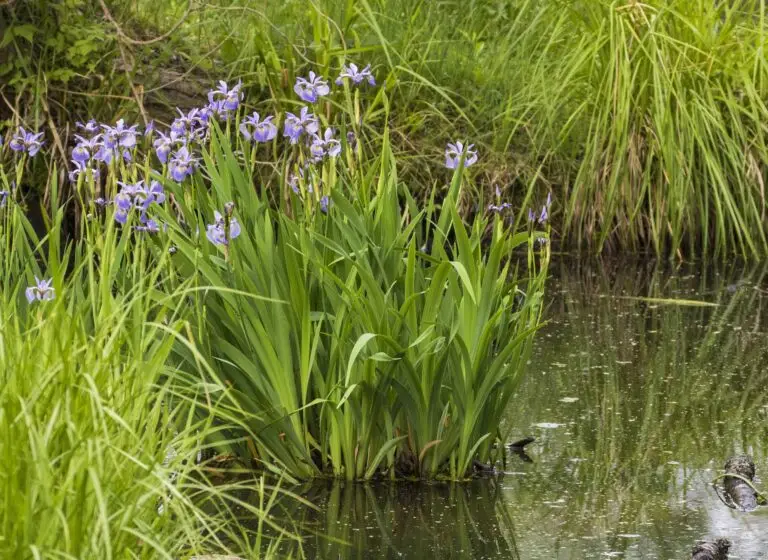
Irises are a gardening staple—did you know there are species native to North America? In this guide, we’ll cover the benefits of planting native irises and introduce you to some native iris options.
First off…
What’s the difference between native and non-native irises?
There are 300+ species of iris found throughout the world. The number rises to an incredible 30,000+ if we include iris cultivars. All irises worldwide have a shared set of similarities. All irises are…
- Perennials. When happy, they come back year after year.
- Grown from a bulb or a rhizome. Iris bulbs and rhizomes are bulbous roots typically planted close to the soil’s surface. The green stems shoot up from this fat rootstock.
- Shaped for pollination. The crazy shape of iris flowers is made to get a pollinator to pollinate. Their petals are pollinator runways.
- Named for the Greek goddess of the rainbow. Iris is the Greek goddess of rainbows. One look at the intricate colors in a native iris tells you where the inspiration came from.
Now that we know what all irises have in common, let’s talk about what makes native irises special.
What are the benefits of planting native irises?
There are so many benefits to planting native irises! A few beneficial reasons include:
- Super low maintenance: Native irises need minimal care to thrive. This is difference from non-native irises, which can requite fertilizers or special care.
- Comes back year after year: this is a perennial plant that comes back year after year, each year doubling in size. So plant once and enjoy for years!
- Instagrammable beauty. Beauty matters! A gorgeous landscape with native flowers lifts spirits. Plant a patch of native irises and see for yourself.
Now that we’ve briefly covered the benefits let’s explore a few native options.
Meet some native iris species
Here are some native irises found in North America that offer beauty, resilience, and fuss-free care. Organized by region:
Native irises for the Eastern Seaboard
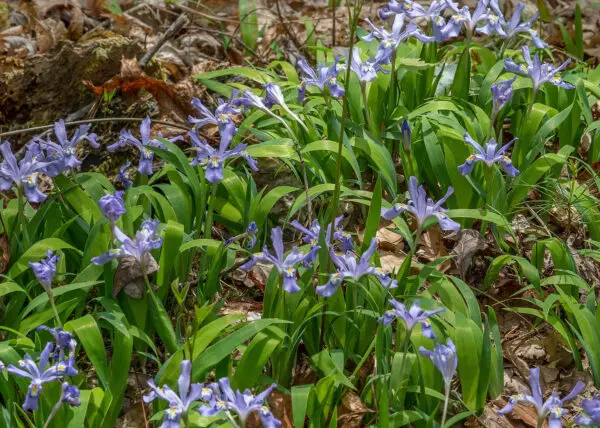
Dwarf Crested Iris
Iris cristata
What a tiny powerhouse! Dwarf Crested Iris thrives in shade to part shade and rich soils. The only things they don’t like are full sun and staying wet. In nature, they are found on forest floors. They are native from Pennsylvania down to Arkansas and Georgia.
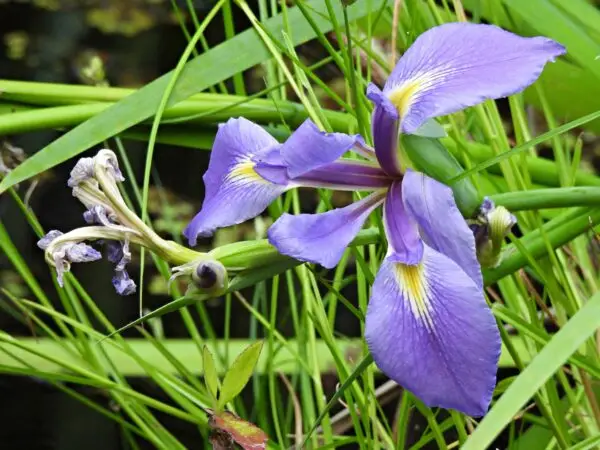
Virginia Iris
Iris virginica
Although it’s sometimes called ‘Virginia,’ you can plant this native iris from Newfoundland south to Florida. (It’s also sometimes called Great Blue Flag Iris, Southern Blue Flag Iris, or simply Blue Flag Iris.)
Plant this native along the water line. It is found in “marshes, swamps, wet meadows, along shorelines, and in forested wetlands” (source: USDA.) 2-3′ feet tall, prefers sunny areas.
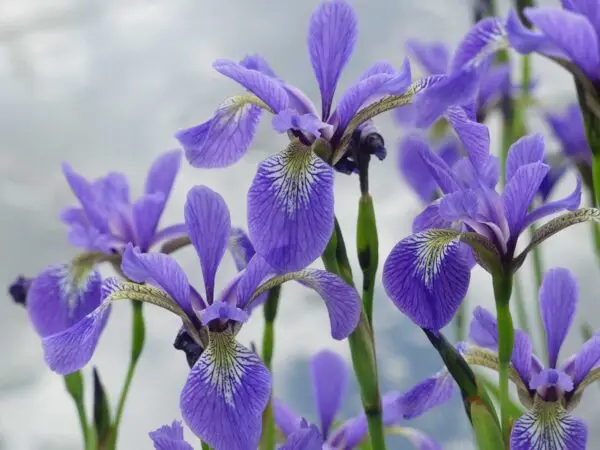
Northern Blue Flag Iris
Iris versicolor
This native iris thrives along the northeastern seaboard from Virginia north to Newfoundland.
Northern Blue Flag Irises love to be near water. You’ll find them alongside streams, lakes, and rivers, and sometimes IN the water, especially in shallow edges.
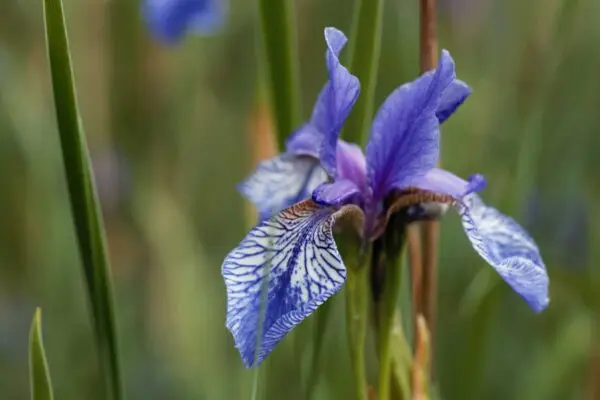
Slender Blue Iris
Iris prismatica
A shorter native iris: 1-2 feet. Native from Maine down to Georgia. As you can imagine from its common name—slender blue—this native flower has a thin, reed-like stem and similarly narrow flowers and leaves. A delicate powerhouse of a plant.
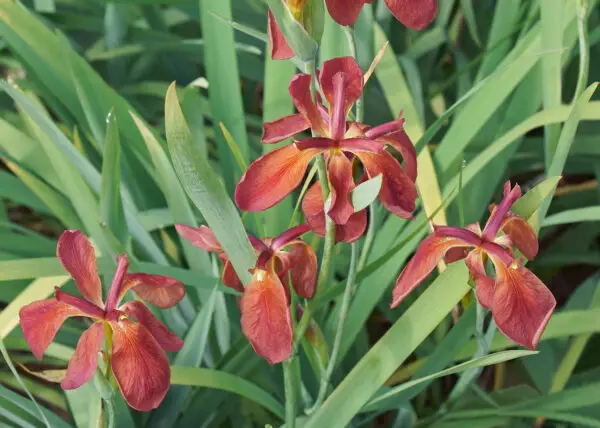
Louisiana Irises
I. brevicaulis, I. fulva, I. giganticaerulea, I. hexagona, I. nelsonii
The five species of ‘Louisiana iris’ are celebrated for their stunning blooms, deep southern roots, and preference for sunny gardens. What makes them truly unique is their ability to interbreed exclusively with one another, resulting in a dazzling array of Louisiana iris cultivars. Among these, the iconic ‘Black Gamecock’ Louisiana iris stands out as a favorite.
Native irises for the Western United States
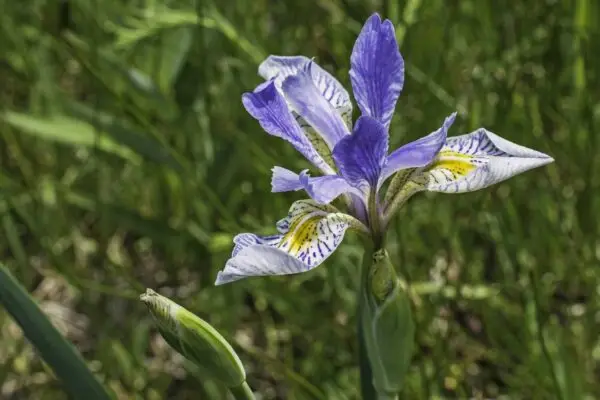
Rocky Mountain Iris
Iris missouriensis
This native iris thrives in the West and Northwest; you’ll find it west of the Sierra Nevada and Cascade mountains.
Like their eastern cousin, Northern Blue Flag, Rocky Mountain Irises love to be near water. You’ll find them alongside streams, lakes, and rivers.
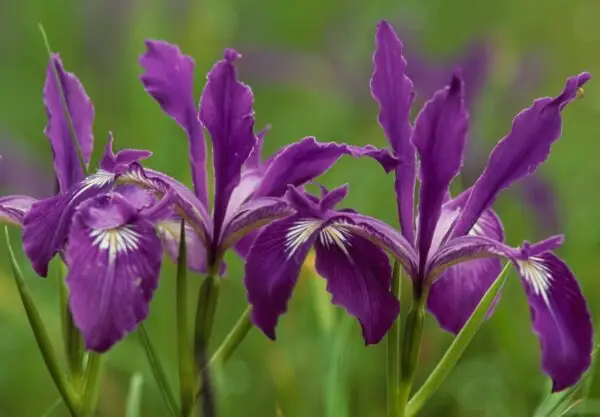
Tough-leaf Iris
Iris tenax
This native iris from the Northwest (Washington/Oregon/California) can have flower petals in various colors, from purple to blue to white to yellow. According to the Wildflowers of North and Central America, “The species name Tenax is from the Latin for ‘tenacious’, referring to the tough leaves, which were once used by Native Americans to make strong, pliable rope and cord.”
Want to meet more native irises?
We are excited to introduce some true iris experts who dig deeper into the iris genus. Find your irises (and your people):
- American Iris Society (gorgeous website, too!)
- Species Iris Group of North America
- Society of Pacific Coast Native Iris
Now that you’ve learned about some North American native options, you may have a few questions. We’ve put together some FAQs below; otherwise, scroll on for planting and sourcing ideas.
FAQs
What does 'bearded' or 'beardless' mean in irises?
‘Bearded’ or ‘beardless’ refers to whether the iris has short hairs on its lower petals. (The lower petals on an iris are called the ‘fall.’)
A quick look and you’ll see the ‘beard’:
Bearded
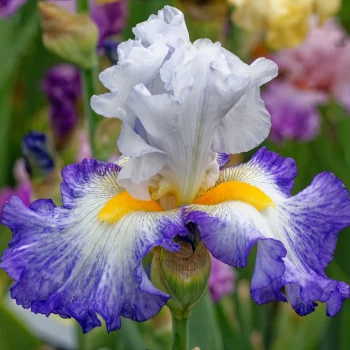
Beardless
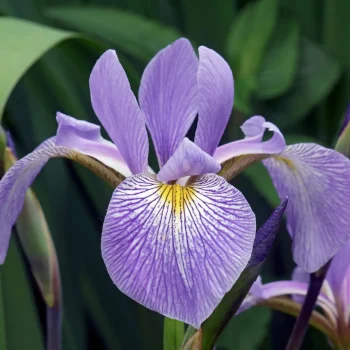
Beards are a good way to tell if the iris is native to North America.
- Bearded irises are non-native. They come from native stock originally from Europe and East Asia.
- All North American native irises are ‘beardless’—no hairs on their lower petals.
However, some non-native irises are also beardless. But the beard is a giveaway for non-native iris species.
If you want to go a bit further reading about beards and iris classification, head over to The American Iris Society’s classification overview. They also introduce a third group of bearded irises called Arils.
Are bearded irises native?
Bearded irises (Iris germanica) are native to Europe and central Asia.
The rainbow of bearded iris colors we see today comes from cultivars—30,000+ cultivars!—that have been made and sold over the past generations. The original species would be difficult to find. “Iris germanica as a species is simply not sold in commerce today,” says the Missouri Botanical Garden.
Head to The American Iris Society’s Iris Encyclopedia to explore thousands of Bearded Iris cultivars.
What native irises are good for a rain garden?
Many species of native iris are great for rain gardens. Some options include:
For eastern rain gardens:
- Northern Blue Flag Iris
- Virginia Iris
- Louisiana Irises
For western rain gardens:
- Rocky Mountain Iris
These native irises are great additions to rain garden planting, and there are lots more native plants that don’t mind some water, too. Read our Best Native Plants for Rain Gardens to meet more water-friendly friends.
Why are so many irises called 'flags'?
According to the NC State Extension Gardener Toolbox:
“The common name, ‘flag’, comes from an old English word (flagge) for reeds and refers to its natural preference to wetlands.”
Now that you know that ‘flag’ relates to water, you can start to pick up which irises are not water-loving—just by the common name. For instance, Dwarf Crested Iris likes drained woodlands, while Northern Blue Flag Iris loves to be near waterways.
Interested in plant names? We are, too. Check out our Terrible Names, Beautiful Native Plants to meet—and laugh—at some simply horrible names. Tickseed, anyone?
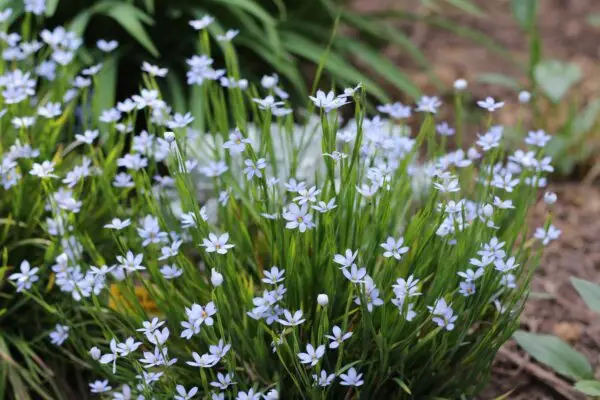
Have a sunny, dry spot?
Meet irises’ cousin: Blue-Eyed Grass
If you love blue flowers and have a well-drained and sunny area, let us introduce you to Blue-Eyed Grass. This short native plant balances tiny blue flowers at the top of grass-like leaves. It loves full sun and doesn’t like to stay wet.
Why are iris flowers that crazy shape?
This quick 2-minute Southern Blue Flag Iris overview from Spring Island Trust explains how the shape and yellow coloring on native iris flowers help bumblebees pollinate this plant.
Where can I find native irises?
We are not going to lie—sometimes finding a specific native plant is challenging. But it gets a lot easier if you know where to look!
Here are four sourcing ideas to help you find native irises:
Where can I find seeds and plants?
Finding native plants can be challenging (we partly blame Marie Antoinette.) To make it easier, we’ve assembled four sourcing ideas.
300+ native nurseries make finding one a breeze
Explore 100+ native-friendly eCommerce sites
Every state and province has a native plant society; find yours
Online Communities
Local Facebook groups are a great plant source
What are good pairings for native irises?
The pairings for native irises depend on the region you’re planting in. Some native iris pairings include:
East Coast pairings
West Coast pairings
Feeling a little overwhelmed picking native plants?
Gardening should be fun and not feel like a botany exam. If you’re feeling overwhelmed as you plan your native garden, check out our inspiration guides. They are all written to help get you gardening (and not worrying.)
To make garden planning easy: Three-Color Native Gardens and Single-Plant Native Gardens are great resources.
Or, if you’re looking to focus on a specific butterfly or bird (or keep deer away!), visit Best Native Plants for Birds, Best Native Plants for Butterflies, and Deer-Resistant Native Plants.
Remember: native plants plant themselves. If they can do it, so can we.
And now you’ve met some native North American irises! All these native irises offer the iconic beauty of irises with the resiliency present in native plants. Non-native bearded irises are lovely, but native irises also deserve the spotlight. Many native iris species thrive in challenging planting areas, like wetlands or rain gardens. Spend time visiting native nurseries to find some, and watch them return years of beauty. Interested in exploring more native faves? Visit our Beginner’s Guide to Coneflowers or our Beginner’s Guide to Native Magnolias. Happy planting!
Sources
- Anderson, Erica. “10 Factoids about Iris.” White Flower Farm’s blog, July 24, 2023.
- Harstad, Carolyn. Go Native! Gardening with Native Plants and Wildflowers in the Lower Midwest. (1999), 209-210.
- Laughlin, Shannon. “Iris.” University of Connecticut, College of Agriculture, Health and Natural Resources Home and Garden Education Center, February 23, 2022.
- Ruffin, Tanya, and Gill, Daniel. “Louisiana Irises.” LSU AgCenter, March 30, 2017.
- Wilson, Carol. “The Iris Genus,” University of California, Berkeley. n.d.
- USDA Plants Factsheet: Blue Flag Iris (PDF).
- Lady Bird Johnson Wildflower Center, Rocky Mountain Iris.
- Lady Bird Johnson Wildflower Center, Northern Blue Flag Iris.
- Lady Bird Johnson Wildflower Center, Slender Blue Iris.
- Lady Bird Johnson Wildflower Center, Virginia Iris.
- American Meadows. “Black Gamecock Louisiana Iris.”
- American Meadows. “All about Irises.” AMI, 2024.
- Contributors. “Louisiana Iris Series of Plants.” Wikipedia.org. Wikimedia Foundation, Inc., August 28, 2012.
- North Carolina Extension Gardener Plant Toolbox. “Iris Virginica (Southern Blue Flag Iris),” 2024.
- US Forest Service. “Our Native Irises: Dwarf Woodland Irises.” n.d.
- US Forest Service. “All About Our Native Irises.” n.d.
- Signa.org. “SIGNA: The Species Iris Group of North America,” 2024.
- Pacificcoastiris.org. “Society for Pacific Coast Native Iris – Home,” 2018.
- Irises.org. “WebHome < Main < Iris Wiki,” 2024.
Blue is a rare color in nature! Here are some other options.
What if your feed was actually good for your mental health?
Give your algorithm a breath of fresh air and follow us.
